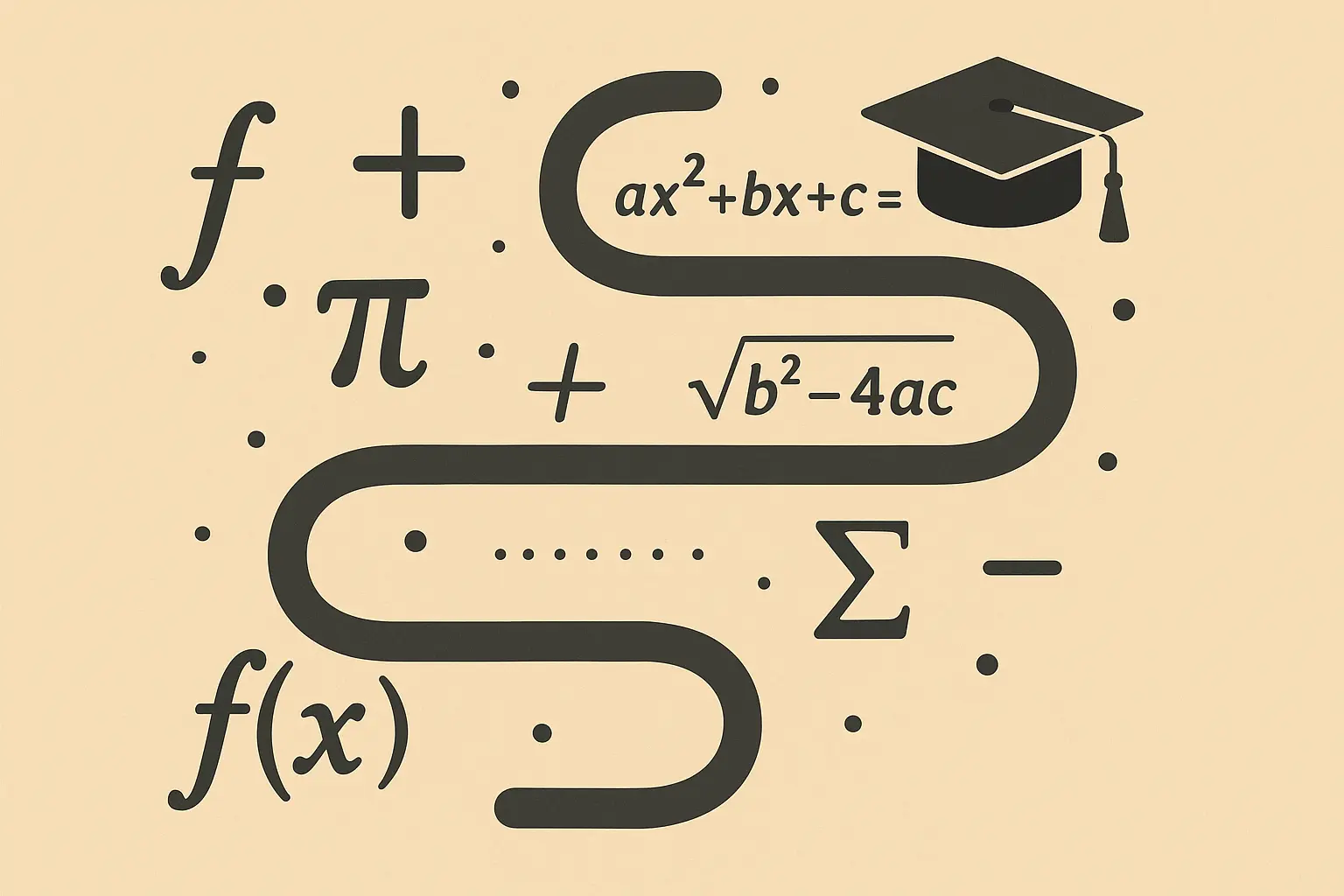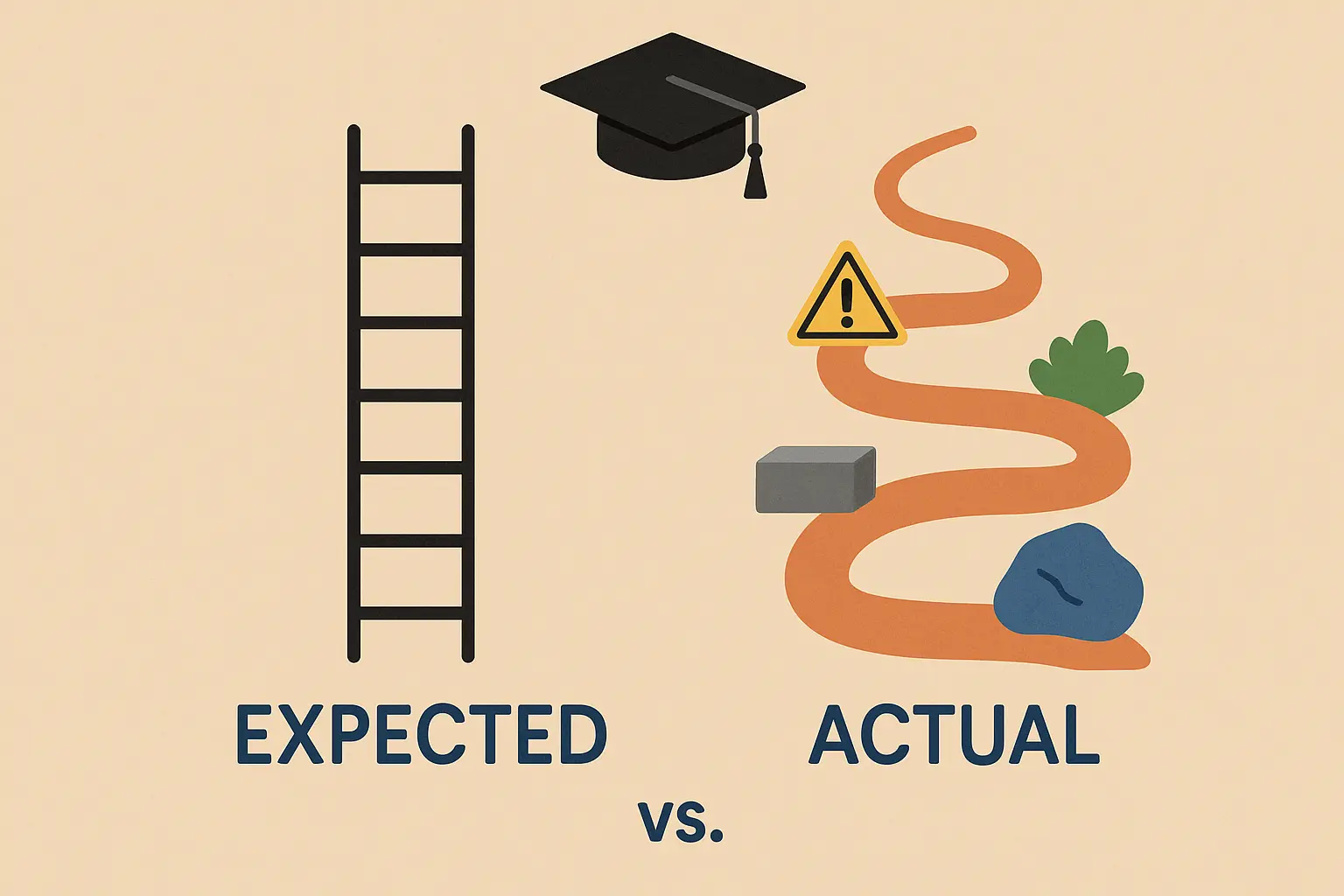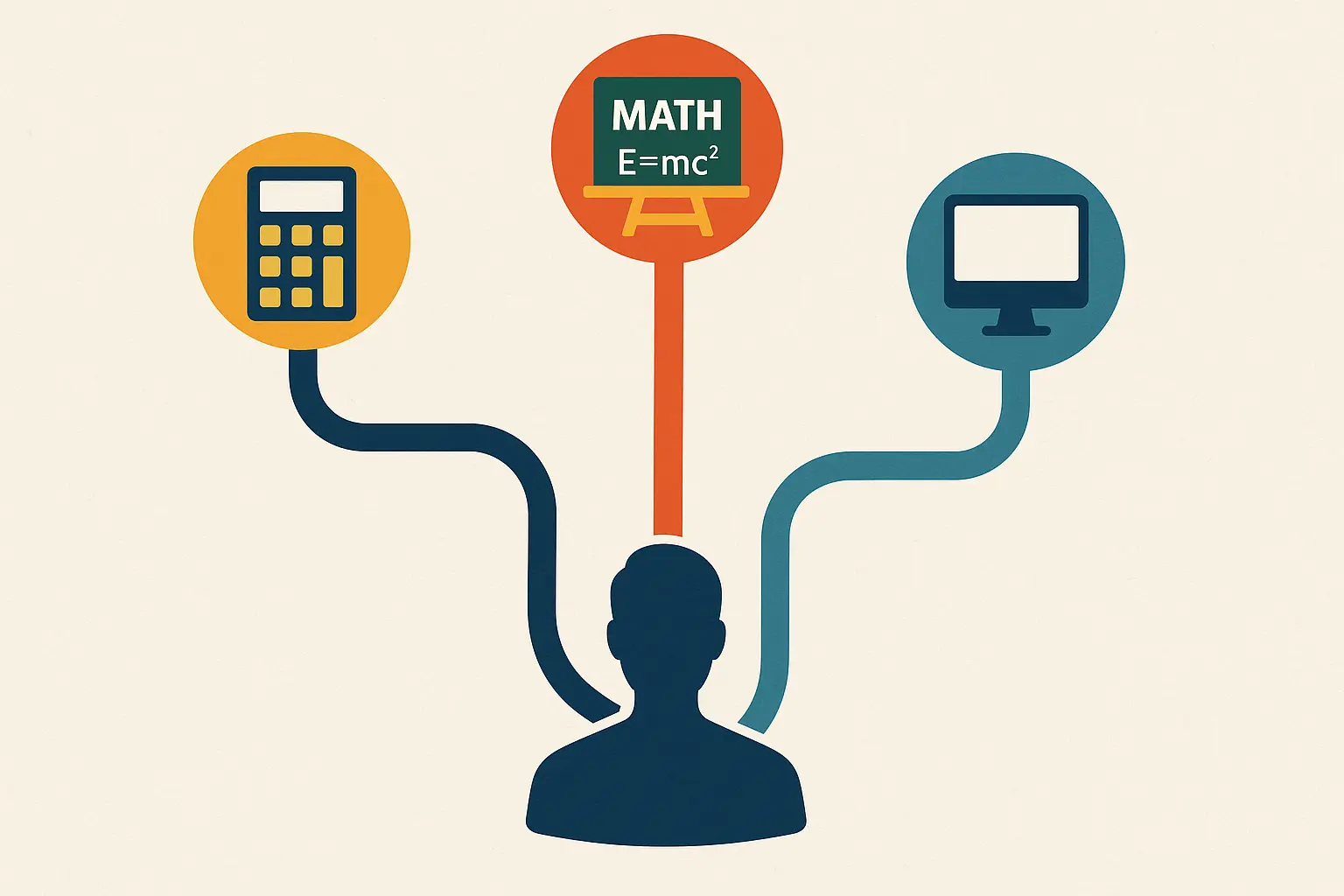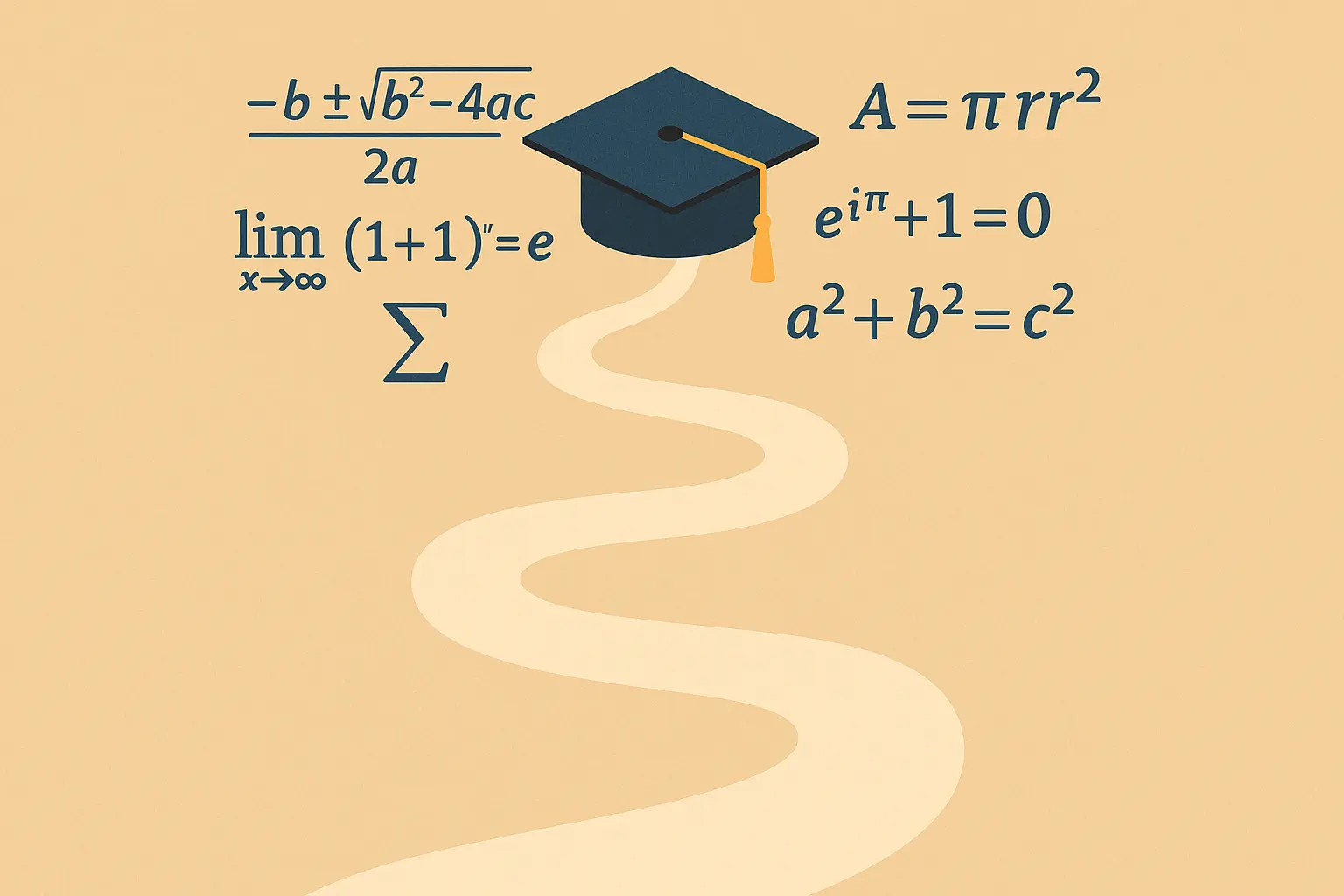Most people think getting a math degree takes four years. Here’s what I wish someone had told me: that’s wishful thinking for the majority of students. After watching countless math majors (including myself) navigate this journey, I’ve seen the reality: most students need 5-6 years to complete their degree, and that’s if everything goes relatively smoothly.
The traditional four-year timeline assumes you’ll breeze through prerequisites, never struggle with a course, and have perfect scheduling alignment. In reality, math programs have structures that create bottlenecks at every turn – and that’s not anyone’s fault, it’s just how mathematics works. According to recent data from the Bureau of Labor Statistics, employment of mathematicians and statisticians is projected to grow 8 percent from 2024 to 2034, much faster than the average for all occupations, making this journey more relevant than ever despite its extended timelines.
I’ll walk you through what actually determines how long your math degree will take, from prerequisite challenges to career-specific requirements that can extend your timeline. Whether you’re just starting out or already deep in your program, understanding these realities will help you plan more effectively and avoid costly surprises.
Table of Contents
-
The Real Story Behind Math Degree Architecture
-
Why Prerequisites Feel Like Quicksand
-
Transfer Student Reality Check
-
Part-Time Programs: The Marathon, Not the Sprint
-
When Your Career Goals Move the Goalposts
-
The Money Talk Nobody Wants to Have
-
When Your Brain Becomes Your Own Worst Enemy
-
How Technology Is Changing the Game
-
ValidGrad: Protecting Your Hard-Earned Achievement
-
The Bottom Line
TL;DR
-
Most math degrees take 5-6 years, not the advertised 4 years, due to prerequisite challenges and sequential course requirements
-
Transfer students often face an additional year due to strict credit evaluation policies in math departments
-
Part-time students should expect 6-8 years for completion due to limited evening course availability
-
Career-specific tracks (actuarial, teaching) can add 1-2 years through additional requirements and certification needs
-
Placement tests frequently reveal the need for refresher coursework, adding 6-12 months before college-level math begins
-
Graduate school preparation requires research experience and exam prep that often extends degree timelines
-
Financial pressures and opportunity costs make each delayed semester increasingly expensive
-
The transition to proof-based mathematics creates psychological challenges that cause many students to retake courses
The Real Story Behind Math Degree Architecture
Here’s the thing nobody tells you when you’re starry-eyed about your math major: those neat little four-year degree plans? They’re more like wishful thinking than reality. I’ve watched so many friends (myself included) discover that math courses are like dominoes – knock one over, and suddenly your whole timeline goes sideways.
Understanding the extended timeline is crucial when considering is it worth it to get a college degree in mathematics, as the investment extends well beyond four years for most students.
Unlike your roommate’s business major where they can shuffle courses around like a deck of cards, math doesn’t play that game. You literally cannot take Calculus III without Calculus II. Sounds obvious, right? But when you’re mapping out your four-year plan as a freshman, it’s easy to forget that life happens. You get sick during finals, work more hours than planned, or maybe Abstract Algebra just kicks your butt the first time around.
“I thought I was being smart by loading up on electives early,” says Maria, who graduated with her math degree last year. “But when I had to retake Differential Equations, suddenly I had no room in my schedule for the upper-level courses I needed. What should have been my senior year became my ‘figure out how to graduate’ year.”
|
Math Degree Timeline Comparison |
Traditional Expectation |
Actual Reality |
Common Delays |
|---|---|---|---|
|
Prerequisites Complete |
Immediate Start |
6-12 months remedial |
Placement test results |
|
Course Sequence |
Linear progression |
Bottlenecks at key courses |
Limited section availability |
|
Full-time completion |
4 years (8 semesters) |
5-6 years (10-12 semesters) |
Failed courses, scheduling conflicts |
|
Transfer credits |
Seamless integration |
Additional 1-2 semesters |
Credit evaluation delays |
|
Career preparation |
Integrated naturally |
Extends timeline 1-2 years |
Certification requirements |
Why Prerequisites Feel Like Quicksand
Math prerequisites create a pyramid structure where each level depends entirely on mastering the previous one. Unlike other majors where you can take courses in flexible orders, mathematics demands sequential completion – you can’t skip Calculus I to get to the “interesting stuff.” This creates bottlenecks that catch most students off guard and can derail even the best-laid graduation plans.
The Placement Test Reality Check
Let’s talk about placement tests for a hot minute. Remember those? The ones you probably took during orientation while you were still figuring out where the bathrooms were? Yeah, those innocent-looking assessments can completely derail your timeline before you even start.
I’m not trying to scare you here – I’m trying to prepare you. About 40% of incoming students discover they need some refresher courses before jumping into college-level math. And you know what? That’s totally okay. It doesn’t mean you’re not cut out for this. It just means high school didn’t quite get you where you need to be, and that’s nobody’s fault.
Real talk moment: If you place into remedial math, don’t panic. I know a brilliant engineer who started in basic algebra and now designs spacecraft. The extra time you spend building a solid foundation will actually make the advanced stuff easier later.
Placement Test Preparation Checklist:
-
Review algebra fundamentals 2-3 months before testing
-
Take practice placement tests from your target institution
-
Identify weak areas and focus study time accordingly
-
Consider summer bridge programs if available
-
Understand retesting policies and timelines
-
Plan for potential remedial coursework in your timeline
-
Research credit-bearing alternatives to remedial courses
When Course Scheduling Becomes a Game of Tetris
Picture this: You need Linear Algebra to take Abstract Algebra. Abstract Algebra is only offered in the fall. You missed Linear Algebra this semester because it conflicted with your work schedule. Congratulations – you just added a year to your degree.
This isn’t anyone being mean to you. It’s just how math departments work because, frankly, they have to. You can’t learn calculus without algebra, and you can’t do real analysis without really understanding calculus. It’s frustrating, but it makes sense when you think about it.
Sarah, a math major at a mid-sized university, failed Calculus II in her sophomore spring semester. Because the course was only offered once per year in the fall, she couldn’t retake it until the following September. This single setback delayed her entire upper-level sequence by a full year, pushing her graduation from 4 years to 5 years, despite maintaining good grades in all other courses.
Transfer Student Reality Check
If you’re transferring into a math program, I have some news that might sting a little. Math departments are basically the TSA of academia – they’re going to scrutinize everything, and they’re not in a hurry about it.
Math departments are notoriously careful about accepting transfer credits, often requiring students to retake foundational courses even when transcripts show completion. This conservative approach can add an entire year to your degree timeline, regardless of your previous academic performance.
“I transferred from community college with what I thought was equivalent coursework,” shares David, now a data scientist. “Turns out their ‘Calculus II’ didn’t cover sequences and series the way my new school required. I had to retake it, which felt like a huge waste of time and money. But honestly? I’m glad they made me do it because I was missing some important concepts.”
The silver lining? Math departments are picky because they want you to succeed. They’ve seen too many students struggle in advanced courses because they had gaps in their foundation.
Credit Evaluation: The Waiting Game
Mathematics departments take their time evaluating transfer credits, and their standards are often higher than other disciplines. What you thought was equivalent coursework might not meet their specific requirements, forcing you to retake classes you’ve already passed. This process can take months to resolve, during which you’re stuck in limbo, unable to register for advanced courses.
When “Calculus II” Doesn’t Mean Calculus II
Here’s something that’ll make your head spin: institutional variation in mathematics standards creates challenges for transfer students. What one school calls “Calculus II” might not align with another institution’s requirements, leaving you with knowledge gaps that require additional coursework to bridge. I’ve seen students discover these discrepancies only after enrolling, when it’s too late to make alternative plans.
Part-Time Programs: The Marathon, Not the Sprint
Working while getting your math degree? First off, you’re a rockstar for even attempting this. Second, let’s be realistic about what you’re signing up for.
Most upper-level math courses happen during business hours because professors assume you’re a traditional student. Evening sections for Real Analysis or Topology? Good luck finding those. This means you’re looking at 6-8 years, and that’s if everything goes smoothly.
Recent data shows that a typical undergraduate mathematics degree program requires four years to complete if you are a full-time student successfully finishing all the coursework on schedule, but part-time students face significantly different realities.
The extended timeline for part-time mathematics students is significantly longer than how long does it take to get a bachelor degree in other fields due to specialized course scheduling requirements.
“I had to use vacation days to take my senior seminar because it was only offered at 2 PM on Tuesdays,” laughs Jennifer, who finished her degree while working full-time. “My boss thought I was crazy, but it was worth it. Just wish someone had warned me about the scheduling nightmare earlier.”
Course Availability: Your New Reality
Upper-level mathematics courses often have limited sections, and most are scheduled during business hours when working students can’t attend. You’ll find yourself waiting entire semesters for courses to fit your schedule, watching full-time students progress while you’re stuck in scheduling limbo. Evening sections for advanced courses are rare, and online options often don’t exist for courses requiring collaborative problem-solving.
Part-Time Student Success Checklist:
-
Map out 6-8 year degree plan with advisor
-
Identify which courses are offered evenings/weekends
-
Plan vacation time for daytime-only courses
-
Research online course options and limitations
-
Connect with other working students for study groups
-
Negotiate flexible work schedule if possible
-
Budget for extended timeline costs
Laboratory and Seminar Requirements You Can’t Escape
Many upper-level math courses include collaborative components, seminars, or lab work that can’t be replicated online or rescheduled for evenings. These requirements force part-time students to make difficult choices between career advancement and degree completion, often resulting in extended timelines as you navigate work-life-school balance.
When Your Career Goals Move the Goalposts
Want to be a teacher? Add student teaching and certification exams. Dreaming of actuarial work? Better start studying for those professional exams. Planning on grad school? Hope you like research and GRE prep.
None of this is bad – it’s just reality. Your career goals will shape your timeline, and that’s actually a good thing. Better to take the time to do things right than rush through and miss opportunities.
The median yearly salary for mathematicians stands at $112,110, with the bottom 10% of earners making below $57,680, while the top 10% earn over $171,540, making the extended timeline investment potentially worthwhile for many career paths.
Actuarial Track: More Than Just Math
Students pursuing actuarial careers need specific coursework and professional exam preparation that significantly impacts degree timelines. You’re not just completing a math degree – you’re preparing for a highly specialized profession with its own requirements and timeline pressures that often conflict with traditional academic scheduling.
Professional Exam Reality
Successful actuaries typically pass 2-3 professional exams during their undergraduate years, but this exam preparation requires dedicated study time that competes directly with coursework demands. You’ll find yourself choosing between maintaining your GPA and advancing your professional credentials, often extending your degree timeline to accommodate both priorities.
Internship Timing Challenges
Actuarial internships have strict application deadlines and specific timing requirements that may force you to delay graduation to gain necessary experience. These internships are crucial for career entry, but they don’t always align with academic calendars, creating scheduling conflicts that extend your overall timeline.
Teaching Certification: The Extra Mile
Mathematics education majors face complex certification requirements that vary by state and significantly impact degree timelines. The required student teaching semester often conflicts with advanced mathematics coursework, and certification exams aren’t offered year-round, potentially creating gaps between degree completion and job market entry.
Recent developments in mathematics education highlight the evolving landscape of degree requirements. As “The study of mathematics offers a dynamic, challenging and opportunity-rich academic journey,” according to Melissa Wittmer, an educator with over 25 years of experience at Southern New Hampshire University, but these opportunities often come with extended timeline requirements that students don’t anticipate.
Teaching certification adds complexity to the question of how long does it take to get a teaching degree when combined with mathematics specialization requirements.
Graduate School Preparation: The Long Game
Students planning for advanced degrees face different timeline pressures than those entering the workforce immediately. Competitive graduate programs expect undergraduate research experience, conference presentations, and strong GRE scores that require additional time investment beyond regular coursework, often extending degree timelines as students balance these requirements with academic performance.
Research Experience: More Than Just Coursework
Competitive graduate programs expect undergraduate research experience that typically requires students to extend their programs or reduce course loads to accommodate research time. Limited faculty availability for undergraduate research mentoring creates waitlists that delay research opportunities, while top programs increasingly expect applicants to have presented research at professional conferences.
GRE and Subject Test Preparation
Graduate school entrance exams require extensive preparation that competes with coursework demands. The Mathematics GRE Subject Test is only offered three times per year, requiring strategic planning that may influence course scheduling and graduation timing as students balance test preparation with maintaining their GPA.
|
Graduate School Preparation Timeline |
Activity |
Time Investment |
Impact on Degree Timeline |
|---|---|---|---|
|
Research Experience |
2-3 semesters |
10-15 hours/week |
May require reduced course load |
|
GRE General Test Prep |
3-6 months |
10-20 hours/week |
Competes with coursework time |
|
Math Subject GRE Prep |
6-12 months |
15-25 hours/week |
Often requires gap semester |
|
Conference Presentations |
1-2 per year |
40-80 hours each |
Time away from classes |
|
Research Paper Writing |
6-18 months |
Variable |
May delay graduation semester |
|
Application Process |
3-6 months |
20-30 hours/week |
Fall semester distraction |
The Money Talk Nobody Wants to Have
Let’s be honest about the elephant in the room: every extra semester costs money. Not just tuition – you’re also delaying your entry into a field where starting salaries are pretty decent.
But here’s the thing – and this might sound like something your mom would say – it’s an investment in yourself. That extra year you spent really understanding the material? It’s going to pay off when you’re confidently tackling problems at your first job while your peers are still googling basic concepts.
The Real Cost of Extended Timelines
The true cost of extending your math degree isn’t just tuition – it’s the opportunity cost of delayed entry into a high-paying field. Mathematics graduates often start with salaries in the $60,000-$80,000 range, making each delayed semester costly in terms of lost earning potential. Add in continued student loan interest accrual, and the financial impact compounds quickly.
Michael’s math degree took 6 years instead of 4 due to some failed courses and part-time enrollment. Beyond the extra $40,000 in tuition and living expenses, he lost two years of potential earnings at his starting salary of $70,000. The total financial impact of his delayed graduation exceeded $180,000 when factoring in lost wages, additional student loan interest, and delayed career advancement opportunities.
Industry Hiring Cycle Misalignment
Many quantitative finance and tech companies have specific hiring seasons, meaning a one-semester delay can result in waiting an entire year for optimal job opportunities. This timing mismatch between academic calendars and industry hiring cycles can significantly impact your career trajectory and starting salary negotiations.
When Your Brain Becomes Your Own Worst Enemy
Can we talk about imposter syndrome for a second? That little voice that whispers “everyone here is smarter than you” gets really loud in math programs. Especially when you hit those proof-based courses and suddenly feel like you’re learning a new language.
The psychological challenges of mathematics education significantly influence completion timelines in ways that academic advisors rarely address. The transition from computational to proof-based mathematics creates mental barriers that cause students to withdraw from courses, switch majors, or extend their timelines unnecessarily.
“I dropped Real Analysis three times before I finally stuck with it,” admits Tom, now a software engineer. “Each time, I convinced myself I wasn’t smart enough. Turns out, I just needed to learn how to think differently about math. And you know what? That skill has been incredibly valuable in my career.”
The transition from computational math to proof-based thinking is rough for everyone. You’re not broken if you struggle with it.
The Perfectionism Trap in Advanced Coursework
Upper-level mathematics courses trigger perfectionist tendencies that lead to course withdrawals and retakes. The transition from solving equations to writing mathematical proofs represents a fundamental change in thinking that many students find overwhelming. Courses like Real Analysis or Abstract Algebra become psychological battlegrounds where students repeatedly drop and retake courses, not because they lack ability, but because they haven’t developed confidence in abstract mathematical reasoning.
Proof-Writing Anxiety That Paralyzes Students
If you’re like me and thought “Real Analysis” sounded like something you’d watch on the Discovery Channel, you’re in for a surprise. The shift from solving equations to writing mathematical proofs represents a fundamental change in thinking that many students find overwhelming. Students often withdraw from challenging courses to protect their GPA, creating a cycle that extends their timeline by 2-3 semesters while they build confidence.
Mental Health Support Checklist for Math Students:
-
Identify campus counseling resources early
-
Join math student support groups or study circles
-
Learn to recognize signs of math anxiety
-
Develop healthy study habits and time management
-
Practice self-compassion when facing setbacks
-
Seek tutoring before falling behind
-
Consider therapy for perfectionism issues
-
Build relationships with faculty mentors
Grade Point Average Protection Behavior
Mathematics students often withdraw from challenging courses to protect their GPA, creating a cycle that extends their timeline by 2-3 semesters while they build confidence. This behavior is particularly common in proof-based courses where students fear the impact of a poor grade on graduate school applications or scholarship eligibility, leading them to repeatedly attempt the same courses until they feel confident enough to see them through to completion.
Research Paralysis in Senior Projects
The open-ended nature of mathematical research can paralyze students who are accustomed to problems with clear solutions, leading to delayed thesis completion. Unlike computational problems with definitive answers, research projects require creativity and tolerance for ambiguity that many students haven’t developed, causing them to struggle with project selection and completion timelines.
Social Isolation and Support System Breakdown
The demanding nature of mathematics coursework can strain relationships and support systems, indirectly affecting completion times. As class sizes shrink in upper-level courses, finding compatible study partners becomes increasingly difficult, while family members often don’t understand the abstract nature of advanced mathematics, creating pressure that affects academic performance.
The Gender and Diversity Timeline Gap
Demographic factors create invisible barriers that extend completion times for underrepresented groups in mathematics. Students from underrepresented backgrounds often lack access to informal mentorship networks, face stereotype threat that affects performance, and encounter gatekeeping in research opportunities that can add significant time to their degree completion.
Mentorship Access Disparities
Students from underrepresented backgrounds often lack access to informal mentorship networks that provide crucial guidance on course sequencing and career planning. The competitive culture in mathematics departments can make office hours feel unwelcoming, while research opportunities are often distributed through informal networks that exclude students who don’t fit traditional demographic profiles.
Stereotype Threat and Performance Impact
The psychological burden of representing an entire demographic group affects academic performance and decision-making in ways that extend timelines. Students may choose easier courses to minimize risk of confirming negative stereotypes, or attribute normal learning struggles to personal inadequacy rather than typical challenges, leading to unnecessary course repeats and extended degree timelines.
The mathematics community continues to grapple with representation challenges, as highlighted by recent breakthroughs. “At 17, Hannah Cairo solved a 40-year-old mystery about how functions behave, called the Mizohata-Takeuchi conjecture,” demonstrating that exceptional mathematical talent can emerge from non-traditional paths, though such success stories remain rare due to systemic barriers.
How Technology Is Changing the Game
Today’s math students need to be part mathematician, part programmer. Suddenly you need to know Python, R, maybe some MATLAB. LaTeX for writing up your work. GitHub for collaborating on projects.
It’s a lot, but it’s also pretty cool. The tools available now would have blown the minds of mathematicians from previous generations. Yes, it adds complexity to your degree, but it also makes you incredibly marketable.
The digital transformation of mathematics education is creating new timeline variables that didn’t exist in traditional programs. Online learning integration, assessment integrity concerns, and the growing emphasis on computational mathematics are reshaping degree requirements and completion expectations in ways that can both accelerate and extend timelines.
Online Learning Integration Challenges
Mathematics concepts often require real-time interaction and immediate feedback, making asynchronous online formats less effective than other disciplines. Students may struggle with time zone complications for live sessions, technology access barriers for required software, and assessment integrity policies that have become stricter in online environments.
Time Zone Complications for Online Programs
Students in different time zones from their institution struggle with live problem-solving sessions that are crucial for mathematics comprehension. This creates learning gaps that require additional study time and often forces students to seek supplemental instruction, extending their overall timeline as they work to master concepts they missed during synchronous sessions.
Academic Integrity Investigations
Increased scrutiny of online mathematics assessments has led to more academic integrity cases, which can freeze a student’s progress for entire semesters during investigation periods. Even unfounded accusations can delay graduation as students wait for resolution, and the stress of these investigations often affects performance in other courses.
Computational Mathematics Integration Requirements
Modern mathematics programs increasingly require proficiency in programming languages like Python, R, or MATLAB that weren’t traditionally part of mathematics curricula. Students now often need computer science courses that may not count toward mathematics degree requirements, effectively extending the total credit hours needed for graduation.
Cross-Disciplinary Course Requirements
Students now often need computer science courses for programming proficiency that may not count toward mathematics degree requirements, effectively extending the total credit hours needed. These additional requirements aren’t always clearly communicated during program planning, leading to surprise timeline extensions when students discover they need technical skills that require separate coursework.
Version Control and Collaboration Tools
Mathematical research increasingly requires familiarity with GitHub, LaTeX, and other technical tools that require time investment outside traditional coursework. Students must learn these tools independently or through workshops, adding to their workload and potentially extending timelines as they balance technical skill development with mathematical content mastery.
Jennifer discovered in her junior year that her intended graduate program required proficiency in Python and LaTeX for mathematical research. Despite having completed all her core mathematics requirements, she needed to take two additional computer science courses and spend a summer learning LaTeX formatting. This unexpected requirement pushed her graduation back by one semester and required an additional $15,000 in tuition and living expenses.
ValidGrad: Protecting Your Hard-Earned Achievement
After all this time, effort, and probably a few mental breakdowns, you’ll have a diploma that represents something pretty amazing. You stuck with one of the most challenging majors through all its quirks and obstacles.
After navigating the complex journey of earning a mathematics degree – whether through traditional timelines, extended programs, or alternative pathways – graduates need to protect their hard-earned credentials. ValidGrad understands that your mathematics degree represents years of rigorous study and intellectual growth that shouldn’t be diminished by lost or damaged diplomas, especially given how frequently math graduates relocate for career opportunities in tech, finance, and research.
Whether it took you four years or seven, that piece of paper represents serious intellectual achievement. Make sure you protect it properly – you’ve earned the right to display it proudly.
Whether you need to replace your diploma after years of moving between research positions or want framed college diploma display options that properly showcase your mathematical achievement, ValidGrad provides comprehensive solutions for protecting your credentials.
ValidGrad’s replica diploma service provides peace of mind by creating high-quality backup copies that allow you to display your achievements while keeping your original safely stored. Whether you need a replacement for a lost diploma, want a display copy for your office, or simply want security knowing you have a backup of this important milestone, our customizable diploma maker ensures your mathematical achievements are properly recognized throughout your career.
Given the extended timelines and significant investment required for mathematics degrees, protecting these credentials becomes essential, especially when considering situations like replacing a lost diploma from institutions that may have changed policies or closed programs over the years.
The Bottom Line
Look, I’m not trying to discourage you from pursuing a math degree. Quite the opposite. I want you to go in with your eyes wide open so you can plan accordingly and not beat yourself up when things don’t go exactly as planned.
The reality of math degree timelines is far more complex than the traditional four-year promise suggests. I’ve walked you through what actually determines how long your math degree will take – from prerequisite challenges and transfer credit issues to career-specific requirements and psychological hurdles that aren’t discussed in admissions materials.
Your timeline is your timeline . Some people finish in four years, others take longer. What matters is that you’re building skills that will serve you for decades to come. The problem-solving abilities, logical thinking, and persistence you develop? Those are worth every extra semester.
“My math degree took six years, and I wouldn’t change a thing,” reflects Sarah, now a data scientist at a Fortune 500 company. “Those ‘extra’ years gave me time to really explore different areas of math, do undergraduate research, and figure out what I actually wanted to do with my life. I’m better at my job because I took the time to really understand the material.”
Understanding these realities upfront allows you to plan more effectively and set realistic expectations. Whether your path includes extended timelines due to part-time study, research requirements, or any of the many factors that influence completion, your mathematical achievement represents significant intellectual growth that deserves recognition and protection.
So take a deep breath, make a realistic plan, and remember – you’ve got this. It might take longer than you initially thought, but the destination is absolutely worth the journey.
When prospective students ask how long does it take to get a math degree, the honest answer involves acknowledging these complex variables rather than offering oversimplified timelines that set unrealistic expectations.










